This is an old revision of this page, as edited by Robert W. Mann (talk | contribs) at 01:25, 13 June 2013 (→Structures). The present address (URL) is a permanent link to this revision, which may differ significantly from the current revision.
Revision as of 01:25, 13 June 2013 by Robert W. Mann (talk | contribs) (→Structures)(diff) ← Previous revision | Latest revision (diff) | Newer revision → (diff)
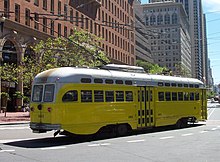

Electric streetcars—trams outside North America—once were the chief mode of public transit in scores of North American cities. Most municipal systems were dismantled in the mid-20th century.
Today, only Toronto and New Orleans still operate streetcar networks that are essentially unchanged in their layout and mode of operation.
Boston, Cleveland, Mexico City, Newark, Philadelphia, Pittsburgh, and San Francisco have rebuilt their streetcar systems as light rail systems. Buffalo, Calgary, Dallas, Edmonton, Houston, Los Angeles, Norfolk, Minneapolis, San Diego, Charlotte, St. Louis and other cities have installed new light rail systems, parts of which run along historic streetcar corridors and in a few cases feature mixed-traffic operation like a streetcar. Portland, Oregon and Seattle have built both modern light rail and modern streetcar systems.
Edmonton, Memphis, Seattle, Vancouver, Whitehorse, and other cities have restored a small number of streetcars to run as heritage lines for tourists.
History
Main article: History of trams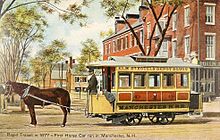
Omnibuses and horsecars
From the 1820s to the 1880s urban transit in North America began when horse-drawn omnibus lines started to operate along city streets. Examples included Gilbert Vanderwerken's 1826 omnibus service in Newark, New Jersey. Before long Omnibus companies sought to boost profitability of their wagons by increasing ridership along their lines. Horsecar lines simply ran wagons along rails set in a city street instead of on the unpaved street surface as the omnibus lines used. When a wagon was drawn upon rails the rolling resistance of the vehicle was lowered and the average speed was increased.
A horse or team that rode along rails could carry more fare paying passengers per day of operation than those that did not have rails. North America's first streetcar lines opened in 1832 from downtown New York City to Harlem by the New York and Harlem Railroad, in 1834 in New Orleans, and in 1849 in Toronto along the Williams Omnibus Bus Line.

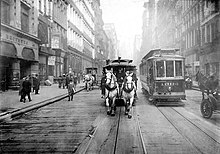
These streetcars used horses and sometimes mules. Mules were thought to give more hours per day of useful transit service than horses and were especially popular in the south in cities such as New Orleans, Louisiana and Celaya, Guanajuato, Mexico. In many cities single animal drawn streetcars were known as "bobtail streetcars" whether mule or horse drawn. By the mid-1880s, there were 415 street railway companies in the USA operating over 6,000 miles (9,700 km) of track and carrying 188 million passengers per year using animal drawn cars. In the nineteenth century Mexico had streetcars in around 1,000 towns and many were animal powered. The 1907 Anuario Estadístico lists 35 animal-powered streetcar lines in Veracruz state, 80 in Guanajuato, and 300 lines in Yucatán.
Although most animal drawn lines were shut down in the 19th century a few lines lasted into the 20th century and later. Toronto's horse drawn streetcar operations ended in 1891. New York City saw regular horsecar service last until 1917 (see photo at left). Pittsburgh, Pennsylvania's Sarah Street line lasted until 1923. The last regular mule-drawn cars in the United States ran in Sulphur Rock, Arkansas until 1926 and were commemorated by a U.S. Postage Stamp issued in 1983. The last mule tram service in Mexico City ended in 1932, and a mule-powered line in Celaya, survived until May 1954. In the 21st century horsecars are still used to take visitors along the 9-kilometre (5.6 mi) tour of the 3 cenotes from Chunkanán near Cuzamá Municipality in the state of Yucatán.
See also: Omaha Horse Railway, Hudson Avenue Line (surface), Palmdale Railroad, and Winnipeg TransitEarly power

During the nineteenth century, particularly from the 1860s to the 1890s, many streetcar operators switched from animals to other types of motive power. Before the use of electricity the use of steam dummies, tram engines, or cable cars was tried in several North American cities. A notable transition took place in Washington, D.C. in the U.S. where horsecars were used on street railways from 1862 to the early 1890s. From about 1890 to 1893 cable drives provided motive power to Washington streetcars, and after 1893 electricity powered the cars. The advantages of eliminating animal drive power included dispensing with the need to feed the animals and clean up their waste. A North American city that did not eliminate its cable car lines was San Francisco and much of its San Francisco cable car system continues to operate to this day.
In this transition period some early streetcar lines in large cities opted to rebuild their railways above or below grade to help further speed transit. Such system would become known as rapid transit or later as heavy rail lines.
Electrification

The first electric street car in America was put into service on Michigan Street in South Bend, Indiana in 1882.
In 1883 Leo Daft built Ampère, an experimental 2 ton electric locomotive in Newark, New Jersey that was intended to pull passengers through the city's streets. Daft's locomotive used one rail to supply and the other rail to return current to the generator. One of the wheels on each axle was insulated from the axle with "vulcanized fiber".

The World Cotton Centennial was held in New Orleans, Louisiana from December 16, 1884 to June 2, 1885. It featured displays with a great deal of electric light illumination, an observation tower with electric elevators, and several prototype designs of electric streetcars. On April 15, 1886 Montgomery, Alabama established its electric streetcar system nicknamed the Lightning Route. Another early electrified streetcar system in the United States was established in Scranton, Pennsylvania by November 30, 1886; it was the first system to be run exclusively on electric power, giving Scranton the nickname "The Electric City". In 1887 an electric streetcar line opened between Omaha and South Omaha, Nebraska. The Omaha Motor Railway Company began operation in 1888.
Along the east coast a large-scale electric street railway system known as the Richmond Union Passenger Railway was built by Frank J. Sprague in Richmond, Virginia, and was operating by February 2, 1888. The Richmond system had a large impact upon the burgeoning electric trolley industry. Sprague's use of a trolley pole for D.C. current pick up from a single line (with ground return via the street rails) set the pattern that was to be adopted in many other cities. The North American English use of the term "trolley" instead of "tram" for a street railway vehicle derives from the work that Sprague did in Richmond and quickly spread elsewhere.
See also: Omaha and Council Bluffs Railway and Bridge CompanyGrowth
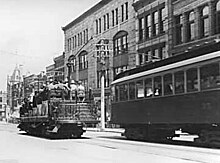
By 1889 110 electric railways incorporating Sprague's equipment had been started or were planned on several continents. By 1895 almost 900 electric street railways and nearly 11,000 miles (18,000 km) of track had been built in the United States.
The rapid growth of streetcar systems led to the widespread ability of people to live outside of a city and commute into it for work on a daily basis. Several of the communities that grew as a result of this new mobility were known as streetcar suburbs. Another outgrowth of the popularity of urban streetcar systems was the rise of interurban lines, which were basically streetcars that operated between cities and served remote, even rural, areas. In some areas interurban lines competed with regular passenger service on mainline railroads and in others they simply complemented the mainline roads by serving towns not on the mainlines.

The Hagerstown and Frederick Railway that started in 1896 in northern Maryland was built to provide transit service to resorts and the streetcar company built and operated two amusement parks to entice more people to ride their streetcars. The Lake Shore Electric Railway interurban in northern Ohio carried passengers to Cedar Point and several other Ohio amusement parks. The Lake Compounce amusement park, which started in 1846, had by 1895 established trolley service to its rural Connecticut location. Although outside trolley service to Lake Compounce stopped in the 1930s, the park resurrected its trolley past with the opening of the "Lakeside Trolley" ride in 1997 which is still operating today as a short heritage line. In the days before widespread radio listening was popular and in towns or neighborhoods too small to support a viable amusement park streetcar lines might help to fund an appearance of a touring musical act at the local bandstand to boost weekend afternoon ridership.
Many of Mexico's streetcars were fitted with gasoline motors in the 1920s and some were pulled by steam locomotives. Only 15 Mexican streetcar systems were electrified in the 1920s.
See also: Trolley park and Setback (land use)Strikes
Main article: Streetcar strikes in the United StatesBetween 1895 and 1929, almost every major city in the United States suffered at least one streetcar strike. Sometimes lasting only a few days, more often these strikes were "marked by almost continuous and often spectacular violent conflict," at times amounting to prolonged riots and civil insurrection.
Streetcar strikes rank among the deadliest armed conflicts in American labor union history. Samuel Gompers of the American Federation of Labor called the St. Louis Streetcar Strike of 1900 "the fiercest struggle ever waged by the organized toilers" up to that point, with a total casualty count of 14 dead and about 200 wounded. The San Francisco Streetcar Strike of 1907 saw 30 killed and about 1000 injured. Many of the casualties were passengers and innocent bystanders.
The 1929 New Orleans streetcar strike was one of the last of its kind. The rise of private automobile ownership took the edge off its impact, as an article in the Chicago Tribune observed as early as 1915.
Decline
Main article: Decline of streetcars in the United States
The Great Depression of the 1930s led to the closure of many streetcar lines in North America. The onset of World War II held off the closure of some streetcar lines as civilians used them to commute to war related factory jobs during a time when rubber tires and gasoline were rationed. After the war automobile use continued to rise and was assisted in the 1940s and 1950s by the passage of the Trans-Canada Highway Act of 1948 and growth of provincial highways in Canada as well as the Federal Aid Highway Act of 1956 in the United States. Declining ridership and traffic jam crowding of city streets by streetcars were often cited as reasons to shut down remaining lines. By the 1960s most North American streetcar lines were closed, with only the exceptions noted above and discussed below remaining in service. The survival of the lines that made it past the 1960s was aided by the introduction of the successful PCC streetcar (Presidents' Conference Committee car) in the 1940s and 1950s in all these cities except New Orleans.
City buses were seen as more economical and flexible: a bus could carry a number of people similar to that in a streetcar without tracks and associated infrastructure. The transit operators in Cambridge, Massachusetts and San Francisco, California removed some streetcar tracks but kept the electric infrastructure so as to run electrified trackless trolley buses (see also Trolleybuses in Dayton, Trolleybuses in Philadelphia, Trolleybuses in San Francisco, Boston-area trackless trolleys, Trolleybuses in Seattle and Trolleybuses in Vancouver). In 2001 Boston started operation of its newly constructed Silver Line trackless trolley service.
See also: Public Utility Holding Company Act of 1935Purported conspiracies

The abandonment of city streetcar systems in the mid-twentieth century, led to accusations of conspiracy which held that a union of automobile, oil, and tire manufacturers shut down the streetcar systems in order to further the use of buses and automobiles. The struggling depression-era streetcar companies were bought up by this union of companies who, over the following decades, dismantled many of the North American streetcar systems.
While it is true that General Motors, Firestone Tire, Standard Oil of California, Phillips Petroleum, and some other companies formed holding companies that purchased several dozen of the hundreds of transit systems across North America, their real goal was to sell their products — buses, tires, and fuel — to those transit systems as they converted from streetcars to buses. During the time the holding companies owned an interest in American transit systems, more than 300 cities converted to buses. The holding companies only owned an interest in the transit systems of less than fifty of those cities, albeit the largest of them. GM and other companies were subsequently convicted in 1949 of conspiring to monopolize the sale of buses and related products via a complex network of linked holding companies including National City Lines and Pacific City Lines. They were also indicted, but acquitted of conspiring to monopolize the ownership of these companies. The latter verdict was upheld on appeal in 1951.
See also: Great American streetcar scandalRenaissance
See also: Light rail in North America § History of Streetcar and Light railThe term light rail was devised in 1972 by the U.S. Urban Mass Transportation Administration to describe new streetcar transformations which were taking place in Europe and being planned in North America. The Edmonton Light Rail Transit became the first urban light rail system in North America. Construction of the Edmonton line started in 1974 and it became operational on April 22, 1978.
Some notable distinctions between light rail systems and their streetcar predecessors were that light rail lines may run at least partially along exclusive rights of way instead of only along streets, a light rail line is more likely to run multiple unit trains instead of single cars, and a light rail line may use high level platforms instead of in street level stops. These design differences mean that light rail systems tend to have more passenger capacity and higher speeds than their streetcar predecessors.
Surviving systems

Not all streetcars systems were removed; the San Francisco cable car system and New Orleans' streetcars are the most famous examples in the United States. San Francisco's conventional electric streetcar system also avoided abandonment, as did that of Toronto and portions of the streetcar systems in Boston, Newark, New Jersey, Philadelphia, Pittsburgh, and Mexico City. The Newark, Philadelphia, and Boston systems ran into subways downtown, while the Pittsburgh and San Francisco systems had tunnels under large hills that had no acceptable road alternatives for bus replacements. The St. Charles Avenue line in New Orleans runs down the park-like "neutral ground" in the centre of St. Charles Avenue, and the surviving Xochimilco line in Mexico City had a similar right-of-way. The only system without these alternatives to street-running to survive was Toronto's. All of these systems have received new equipment. Some of these cities have also rehabilitated lines, and Newark, New Orleans, and San Francisco have added trackage in recent years. In Philadelphia, a former trolley line that was "bustituted" recently resumed trolley service using rebuilt historic cars. Two other former trolley lines are planned to resume trolley service in the 2010s.
In Canada, most cities once had a streetcar system, but today the Toronto Transit Commission (TTC) is the only traditional operator of streetcars, and maintains the Western Hemisphere's most extensive system in terms of track length, number of cars, and ridership. The city added two lines in recent years, and is upgrading its other lines. Expansion is planned in combination with the city's plans for the rejuvenation of its waterfront.
New systems
See also: Light rail in North America
Several North American cities have built light rail systems, some of which operate partially in the right-of-way of city streets. Other new systems are genuine tramways, with smaller vehicles and mixed-traffic street running (no separation from other vehicles), similar to those in New Orleans and San Francisco, although the term streetcar—rather than the European term, tramway—is the name used by the residents there. The pioneering light rail system in Edmonton, which used mostly European technology, does not use street running, and tunneling in the central area accounted for much of the high expense of building that system. It was soon followed by installations in San Diego and Calgary that used similar vehicles but which avoided the expense of tunnels by using surface alignments and, on a few sections, even partial street running, in reserved lanes (restricted to transit vehicles only).
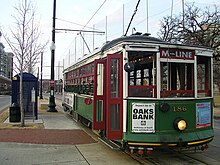
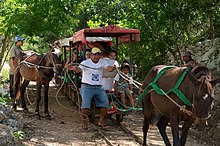
Prior to 2001, the new streetcar systems opened in North America were heritage lines, alternatively known as vintage trolley or ‘historic’ trolley lines. Several cities built new heritage streetcar lines in the 1980s and 1990s, some served only on weekends while others operate daily, year-round and all day, providing true public transit service as opposed to being a tourist- or history-oriented excursion service. New streetcar systems providing daily, year-round service included ones opened in Seattle (the Waterfront Streetcar) (1982), Galveston (1988), Dallas (McKinney Avenue Transit Authority) (1989), Memphis (1993) and Kenosha, Wisconsin (2000). All of these were newly constructed systems, but all are served by historic streetcars or replicas of historic streetcars (although the Seattle Waterfront line has since closed). Others have since opened in Tampa and Little Rock; see Heritage streetcar systems, below.

In 2001, Portland, Oregon, which already boasted a successful light rail system (MAX), became the first city in North America in more than 50 years to open a new streetcar system served by modern vehicles, with the opening of the Portland Streetcar. It uses low-floor cars built in the Czech Republic, but the system's first US-built streetcar was delivered in 2009. The line serves as a downtown circulator between the central city core, the Pearl District and Northwest Portland, Portland State University, and in 2005 was extended to the South Waterfront district, a new mixed-use development along the Willamette River shoreline. Running almost entirely on streets and without any separation from other traffic on most sections, it complements the MAX light rail system, which covers much longer distances and serves as a regional, higher-capacity rail system for the metropolitan area. The MAX system also runs along streets in central Portland, but is separated from traffic (other than buses) even in those areas, via reserved light-rail-only lanes. Construction of a second streetcar line, to the city's east side, began in August 2009.
The new Portland system and several of the new heritage streetcar systems have been intended, in part, as a way of influencing property development in the corridors served, in such a way as to increase density while attracting residents interested in relatively car-free living. The Portland Streetcar is considered to have been very successful in this regard.
North America's second modern streetcar system opened in 2007 in Seattle, where the city's transportation department led the project to construct the South Lake Union Streetcar, but has contracted with local transit authority King County Metro to operate the service. Connecting the neighborhood south of Lake Union with the transit core of downtown Seattle, it operates every 15 minutes and is served by three low-floor streetcars of the same type as some of those in Portland. Residents of the area began referring to the system as the "South Lake Union Trolley" giving it the amusing but unfortunate acronym of "SLUT". Subsequently (in 2009), Seattle has also opened a light rail system (Central Link). Expansion of the streetcar system is planned, with a line serving First Hill under construction.
A new rail line which opened in Tacoma, Washington in 2003, Tacoma Link, is sometimes referred to as a streetcar line because of its short length and use of single vehicles (rather than trains) of the same type as the low-floor streetcars used in Portland. However, the line is separated from other traffic over nearly its entire length, making it less a streetcar than light rail, which is what its operator (Sound Transit) considers it to be.
New tram systems have now opened in many other cities, starting with the ground-breaking system in Edmonton in 1978, and now including Baltimore, Buffalo, Calgary, Charlotte, Dallas (DART), Denver, Edmonton, Houston, Greater Jersey City (HBLR), Los Angeles, Minneapolis, Ottawa, Phoenix, Portland, Sacramento, St Louis, Salt Lake City, San Diego and San Jose.
Additionally, all of the surviving PCC operators have replaced their PCC cars with light rail vehicles, although restored vintage PCC cars are still in regular operation on Boston's MBTA Red line Ashmont-Mattapan High Speed Line, and on San Francisco's F Market line, a line popular among tourists. This line was extended to the Fisherman's Wharf area in 2000, and a second line along the Embarcadero to the east is in the planning stages.
In development
Some 70 US cities have studied the idea of bringing back streetcars as transit, although to date the number that have come to fruition has been small. In the 2000s, one factor in this was opposition from the Federal Transit Administration (FTA) under the Bush Administration. However, under the Obama Administration the FTA has indicated it supports cities interested in building new streetcar systems.
Construction of a new streetcar line in Washington, D.C., the DC Streetcar, got under way in 2009 following several delays.
Tucson, Arizona began construction of the Sun Link modern streetcar line in March 2012. The system's 3.9-mile (6.3 km) route will connect new development on Tucson's west side, the convention center, downtown, and the University of Arizona. Service is scheduled to begin by late 2013.

A new system is proposed for Vancouver, B.C., and for a period of two months centred around the 2010 Winter Olympics a temporary streetcar service was operated, along a modified section of an existing heritage streetcar line (the Vancouver Downtown Historic Railway), connecting the Granville Island district to the Olympic Village Station on the SkyTrain rapid-transit system. Named the Olympic Line, the 1.8-kilometre (1.1 mi) route was served by two Bombardier Flexity Outlook low-floor trams on loan from Brussels, Belgium, and was operated for a period of two months, starting on January 21, 2010.
The First Hill Streetcar is a new streetcar line under construction in Seattle, Washington.
In Atlanta, a new modern streetcar (called simply the Atlanta Streetcar) is under construction which will connect the downtown tourist attractions with the Martin Luther King, Jr. National Historic Site just east of Downtown.
The Delmar Loop Trolley is a proposal to restore a heritage style service to St. Louis, Missouri with replica streetcars.
The Cincinnati Streetcar is a proposal to build a new circulator route in downtown Cincinnati, Ohio, with plans to expand new routes running north to Uptown neighborhoods and the University of Cincinnati. The loop will be four miles long with stops every couple blocks to provide easy mobility around the downtown area. The loop will be serviced by five modern style streetcars, running 7 days a week.
Construction is set to begin in 2014 on a 2.7 mile streetcar system in Fort Lauderdale, Florida. In June 2012, the US Department of Transportation announced an $18 million federal TIGER 4 award for the project.
The Downtown/RiverFront Streetcar is a plan to restore streetcar service between downtown Sacramento, California and the City of West Sacramento across the historic Tower Bridge.
See also: Minneapolis Streetcar System, Sugar House Streetcar (Salt Lake City), and Tacoma StreetcarRecently closed systems
A heritage trolley in Detroit, Michigan operated from 1976 until 2003. The Detroit trolley faced a steep decline in ridership after the Detroit People Mover system was installed and the tracks and carbarn for the former narrow gauge trolley have been removed.
The Waterfront Streetcar in Seattle, Washington operated from 1982 until 2005 when the line's carbarn was demolished to make room for the Olympic Sculpture Park.
Heritage streetcar systems

Heritage streetcar systems are used in public transit service, combining light rail efficiency with tourist's nostalgia interests. Proponents claim that using a simple, reliable form of transit from 50 or 100 years ago can bring history to life for 21st century visitors. Systems are operating successfully in over 30 U.S. cities, and are in planning or construction stages in 40 more. Heritage systems currently operate in Charlotte, North Carolina; Little Rock, Arkansas; Memphis, Tennessee; Dallas, Texas; Tampa, Florida; Kenosha, Wisconsin; and New Orleans, Louisiana are among the larger.
In the province of British Columbia, Vancouver has the Vancouver Downtown Historic Railway system that will be expanded to cover the south downtown area. In Nelson, British Columbia, a small town to the north of Spokane, Washington, the Nelson Electric Tramway Society has rebuilt and runs a restored Streetcar 23 along the lakeside and Baker Street. In Whitehorse, Yukon the Miles Canyon Historic Railway Society has operated the Whitehorse trolley along the Yukon River since 2000.
The new streetcar system which opened in 2000 in Kenosha is a downtown circulator also serving government offices; the upscale HarborPark recreational, cultural, and residential district; and public bus and Metra rail service. It is served exclusively by restored 1940s-vintage PCC streetcars acquired secondhand from Toronto.
Over 50 years after the Tennessee Williams play A Streetcar Named Desire opened on Broadway, the revival of streetcar operations in New Orleans is credited by many to the worldwide fame gained by the streetcars made by the Perley A. Thomas Car Works. These cars were operating on the system's Desire route in the 1947 play and later movie of the same name. Some of the original cars have been carefully restored locally and continue to operate in the 21st century.
Examples in North America include San Pedro, Little Rock, Dallas, Denver, Memphis, Tampa, Seattle, Charlotte, the new Canal Street line in New Orleans, and the reintroduction of the historic Girard Street line in Philadelphia.
Other individual heritage streetcar lines include:
|
|
Museums
Unlike a heritage system a streetcar museum may offer little or no transport service. If there are working streetcars in a museum's collection any service provided may be seasonal, not follow a schedule, offer limited stops, service only remote areas, or otherwise differ from a regularly scheduled heritage line. Some North American streetcar museums include:
|
|
See also
General articles
System lists
|
- List of rail transit systems in the United States (current systems only; list is not limited to streetcar/tram systems)
Specific systems
Operating
|
|
Not operating
|
Car builders and types
See also: List of tram builders, Category:Tram vehicles of Canada, Category:Tram vehicles of Mexico, Category:Tram vehicles of the United States, and Category:Tram manufacturersStructures
Standing
|
|
Not standing
|
|
External links
- Streetcar City Documentary produced by Oregon Public Broadcasting
Notes
- Branley, Edward. "Canal Streetcar (dot com)". Retrieved 2008-12-28.
- "A Bob-tail car run into". New York Times. 1898-11-19.
- "Letter to editor". New York Times. 1881-10-12.
- ^ Allen Morrison. "THE TRAMWAYS OF MEXICO". Retrieved 2008-12-22.
- "Sulphur Rock Street Car; Encyclopedia of Arkansas History & Culture". Retrieved 2008-12-23.
- Allen Morrison. "The Indomitable Tramways of Celaya". Retrieved 2008-12-22.
- "Cenotes at Cuzama - Yucatan Today". Retrieved 2011-03-13.
- "WarriorSelf Weblog » Cuzamá, Mexico". Retrieved 2011-03-15.
- Cerny, Louis; Morrison, Allen. "Yucatán Narrow Gauge by Louis Cerny". Retrieved 2011-05-05.
- Tindall, Dr. William (1918). Records of the Columbia Historical Society, Washington, D.C.: Beginning of Street Railways in the National Capital. Charlottesville, VA: Columbia Historical Society. pp. 24–118.
- "History of South Bend". Retrieved 2011-05-03.
- ^ Thompson, Joe (ed.). "The Cable Car Home Page - Selected Articles From Manufacturer and Builder". Retrieved 2011-02-07. Cite error: The named reference "thompson" was defined multiple times with different content (see the help page).
- John Kendall (1922). "History of New Orleans; Chapter XX1X: The World's Cotton Centennial Exposition".
- "Charles J. Van Depoele". Retrieved 14 December 2008.
- "Electric City Trolley Museum". Retrieved 14 December 2008.
- "Scranton gained fame as the Electric City, thanks to the region's innovative spirit". Retrieved 29 January 2010.
- ^ Liz Rea. "History at a Glance: A Guide to Businesses, Institutions, Organizations, People and Events that Shaped the History of Omaha and the Douglas County Area, 1671-2005" (PDF). Retrieved 2008-12-27.
- "America on the Move - Growth of the Capital's Suburbs". National Museum of American History. Retrieved 2008-12-30.
- H.B. Craig, II. "DETROIT TRANSIT HISTORY: The Pingree Years (1890--1900)". Retrieved 2008-12-30.
- ^ Strikebreaking & intimidation: mercenaries and masculinity in twentieth ... By Stephen Harlan Norwood, page 36
- Motorman and Conductor, June 1900
- Strikebreaking & intimidation: mercenaries and masculinity in twentieth ... By Stephen Harlan Norwood, page 69
- Black, Edwin (2007). "Chapter Ten: 'The GM Conspiracy'". Internal Combustion: How Corporations and Governments Addicted the World to Oil and Derailed the Alternatives. Macmillan. pp. 193–260.
- Bottles, Scott, "Los Angeles and the Automobile: The Making of the Modern City" (Berkeley, CA: UC Press, 1987)
- Cosgrove, Christine (Winter 2004-Spring 2005). "Roger Rabbit Unframed: Revising the GM Conspiracy Theory". ITS Review Online. 3 (1). Retrieved 2009-06-19.
{{cite journal}}: Check date values in:|date=(help) - Martha J. Bianco, Kennedy, "60 Minutes, and Roger Rabbit: Understanding Conspiracy-Theory Explanations of the Decline of Urban Mass Transit", Portland State University Center for Urban Studies Discussion Paper 98-11, November, 1998
- Slater, Cliff (Summer 1997). "General Motors and the Demise of Streetcars" (pdf). Transportation Quarterly. 51 (3): pages 45–66. Retrieved 2009-06-19.
{{cite journal}}:|pages=has extra text (help) - Walter C. Lindley (January 3, 1951). "UNITED STATES v. NATIONAL CITY LINES, Inc., et al". United States Court of Appeals for the Seventh Circuit. Archived from the original on 2008-06-08. Retrieved 2010-12-01.
- "ETS Photo Express - ETS - 1977 Siemens / DüWag U2". Retrieved 2009-01-01.
- Taplin, M. R. (October 2001). "Return of the (modern) streetcar: Portland leads the way". Tramways & Urban Transit. Hersham, Surrey, UK: Ian Allan Publishing Ltd. ISSN 1460-8324. Retrieved 2009-12-07.
- "Portland streetcars--something old, something new". Portland Business Journal. July 19, 2001. Retrieved 2009-12-07.
- Brugger, Joe (July 1, 2009). "Transportation secretary watches as 'Made in USA' streetcar makes debut". The Oregonian. Retrieved 2009-12-07.
- Foden-Vencil, Kristian (August 10, 2009). "Portland Streetcar Begins Work on Next Extension". Oregon Public Broadcasting. Retrieved 2009-12-07.
- ^ Schneider, Keith (October 24, 2007). "A streetcar named development". The New York Times. Retrieved 2009-12-07.
{{cite news}}: Italic or bold markup not allowed in:|publisher=(help) - "Portland Streetcar Development-Oriented Transit" (PDF). Portland Streetcar, Inc. January 2006. Retrieved 2009-12-07.
- Seattle Times Staff (December 12, 2007). "Streetcar starts service". The Seattle Times. Retrieved 2009-12-07.
{{cite news}}: Italic or bold markup not allowed in:|publisher=(help) - Murakami, Kery (September 18, 2007). "SLUT -- Streetcar's unfortunate acronym seems here to stay". The Seattle Post-Intelligencer. Retrieved 2008-01-26.
{{cite web}}: Italic or bold markup not allowed in:|publisher=(help) - ^ Mulady, Kathy (December 9, 2008). "Council OKs streetcar network". The Seattle Post-Intelligencer. Retrieved 2009-12-07.
{{cite news}}: Italic or bold markup not allowed in:|publisher=(help) - "Link Light Rail (Tacoma Link) Schedule & Map". Sound Transit. Retrieved 2009-12-07.
- Rivera, Dylan (December 27, 2007). "Federal rules prefer buses over streetcar expansion". The Oregonian. Retrieved 2009-12-07.
{{cite news}}: Italic or bold markup not allowed in:|publisher=(help) - ^ Rivera, Dylan (October 22, 2009). "U.S. inks deal for millions for Portland Streetcar, pledges more nationwide". The Oregonian. Retrieved 2009-12-07.
{{cite news}}: Italic or bold markup not allowed in:|publisher=(help) - "U.S. Transportation Secretary Announces $280 Million for Streetcars" (Press release). United States Department of Transportation. December 1, 2009. Retrieved 2009-12-07.
- "Transportation Secretary Rides Portland Streetcar". Oregon Public Broadcasting. July 1, 2009. Retrieved 2009-12-07.
- O'Connell, Jonathan (October 15, 2009). "Streetcars still desired in D.C." Washington Business Journal. Retrieved 2009-12-07.
{{cite news}}: Italic or bold markup not allowed in:|publisher=(help) - Seberger, Will (April 12, 2012). "City breaks ground on Modern Streetcar". TucsonSentinel.com. Retrieved August 20, 2012.
{{cite news}}: Italic or bold markup not allowed in:|publisher=(help) - "Olympic Line". The City of Vancouver. Retrieved 2010-04-18.
- "Vancouver's free streetcar makes first run to Granville Island". CBC News. January 21, 2010. Retrieved 2010-04-18.
- "The Loop Trolley - Home". Retrieved 2010-11-06.
- "City of Cincinnati Projects - Streetcar". Retrieved 2011-07-18.
- "Cincinnati Streetcar FAQs". Retrieved 2011-07-18.
- "Streetcar Construction". Retrieved 2012-09-24.
- "Streetcar Grant" (PDF). Retrieved 2012-09-24.
- "Sacramento Streetcar Study - Home". Retrieved 2013-01-28.
- "Nelson Electric Tramway Society". Retrieved 2008-12-19.
- "Whitehorse Waterfront Trolley". Retrieved 2011-07-28.
- "El Reno Heritage Express Trolley". Retrieved 2008-12-19.
- "Tour - Attractions ... El Reno Oklahoma". Retrieved 2009-06-24.
- "River Street Streetcar". Retrieved 2008-12-21.
- "River Street streetcar arrives - News - City Notebook - Connect Savannah - Savannah". Retrieved 2008-12-21.
- "Free Streetcar Rides a Success on River St". WSAV. Retrieved 2008-12-21.
- "Lowell Overview". Retrieved 2008-12-19.
- The Museo opened in November 2006. See "Proyectos.- Servicio de Transportes Eléctricos del D.F." Retrieved 2010-04-21.
- "Collection at the Museum of Transportaion: Interurban & City Transit". Retrieved 2011-02-07.
- "Train Ride at the Museum of Transportaion". Retrieved 2011-02-07.
- "Melbourne Tramways of Australia built the electric W-5 class streetcars in the 1920s and 30s". Retrieved 2009-06-23.
- Morekis, James (November 19, 2008). "River Street streetcar arrives". Retrieved 2009-06-20.
| Currently operating passenger rail, light rail, commuter rail, and rapid transit systems in Mexico | ||||
|---|---|---|---|---|
| Currently operating light rail and streetcar systems in the United States | |||||||||||||||||||||||||||||||||||||||||||||||||||||||
|---|---|---|---|---|---|---|---|---|---|---|---|---|---|---|---|---|---|---|---|---|---|---|---|---|---|---|---|---|---|---|---|---|---|---|---|---|---|---|---|---|---|---|---|---|---|---|---|---|---|---|---|---|---|---|---|
| |||||||||||||||||||||||||||||||||||||||||||||||||||||||
| Italics denote non-transit streetcar lines, operating only on limited dates and usually not year-round, for tourism or educational purposes.
Other transit in the United States: | |||||||||||||||||||||||||||||||||||||||||||||||||||||||
| Rail transport in Central America | |
|---|---|
| Sovereign states | |